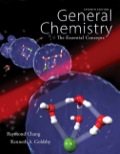
Interpretation:
Concept Introduction:
Chemical reaction:
(1) Atoms are rearranged by the breaking and forming of
(2) Only electron in the atomic or molecular orbitals are involved in the reaction.
(3)Reactions are accompanied by the absorption or release of the relatively small amount of energy.
(4)Rates of reaction are influenced by temperature, pressure, concentration, and catalysts.
Nuclear reactions:
(1) In nuclear reaction the elements are converted to other elements or isotope.
(2) In nuclear reaction the proton, neutron, electron, and other subatomic particle such as alpha- particle may be involved.
(3) In nuclear reaction the reaction are accompanied by the absorption or liberation of tremendous amount of energy.
(4) In nuclear reaction the
To explain:-The basic difference in the nuclear reaction and ordinary chemical reaction.
Answer to Problem 21.1QP
Nuclear reactions are differing from ordinary chemical reaction by the following way.
- (1) In chemical reaction atoms are rearranged by breaking and making of chemical bonds. But in reaction one elements is converted to other elements.
- (2) In chemical reaction atoms or molecular orbitals are involved in the reaction but in nuclear reaction proton, neutron, electrons and other subatomic particles such as alpha-particles. This particle may be involved.
- (3) Chemical reaction is accompanied by the absorption or release of relatively small amount of energy whereas nuclear reactions are accompanied by the absorption of tremendous amount of energy.
- (4) In case of chemical reaction the rate of reaction are influenced by the temperature, pressure, concentration and catalysis. But the nuclear reactions are normally not affected by temperature, pressure or catalysis.
Explanation of Solution
Nuclear reactions are differing from ordinary chemical reaction by the following way.
It’s briefly explained below:
In chemical reaction atoms are rearranged by breaking and making of chemical bonds. But in ordinary reaction one elements is converted to other elements.
In chemical reaction atoms or molecular orbitals are involved in the reaction but in nuclear reaction proton, neutron, electrons and other subatomic particles such as alpha-particles. This particle may be involved.
Chemical reaction is accompanied by the absorption or release of relatively small amount of energy whereas nuclear reaction are accompanied by the absorption of tremendous amount of energy.
In case of chemical reaction the rate of reaction are influenced by the temperature, pressure, concentration and catalysis. But the nuclear reaction are normally not affected by temperature, pressure or catalysis
The deference is briefly explained by considering the nature of chemical reaction and nuclear reaction.
Want to see more full solutions like this?
Chapter 21 Solutions
EBK GENERAL CHEMISTRY: THE ESSENTIAL CO
- Identify the compound with the longest carbon - nitrogen bond. O CH3CH2CH=NH O CH3CH2NH2 CH3CH2C=N CH3CH=NCH 3 The length of all the carbon-nitrogen bonds are the samearrow_forwardIdentify any polar covalent bonds in epichlorohydrin with S+ and 8- symbols in the appropriate locations. Choose the correct answer below. Η H's+ 6Η Η Η Η Η Ηδ Η Ο Ο HH +Η Η +Η Η Η -8+ CIarrow_forwardH H:O::::H H H HH H::O:D:D:H HH HH H:O:D:D:H .. HH H:O:D:D:H H H Select the correct Lewis dot structure for the following compound: CH3CH2OHarrow_forward
- Rank the following compounds in order of decreasing boiling point. ннннн -С-С-Н . н-с- ННННН H ΗΤΗ НННН TTTĪ н-с-с-с-с-о-н НННН НН C' Н н-с-с-с-с-н НН || Ш НННН H-C-C-C-C-N-H ННННН IVarrow_forwardRank the following compounds in order of decreasing dipole moment. |>||>||| ||>|||>| |>|||>|| |||>||>| O ||>>||| H F H F H c=c || H c=c F F IIIarrow_forwardchoose the description that best describes the geometry for the following charged species ch3-arrow_forward
- Why isn't the ketone in this compound converted to an acetal or hemiacetal by the alcohol and acid?arrow_forwardWhat is the approximate bond angle around the nitrogen atom? HNH H Harrow_forwardOH 1. NaOCH2CH3 Q 2. CH3CH2Br (1 equiv) H3O+ Select to Draw 1. NaOCH2 CH3 2. CH3Br (1 equiv) heat Select to Edit Select to Drawarrow_forward
- Complete and balance the following half-reaction in acidic solution. Be sure to include the proper phases for all species within the reaction. S₂O₃²⁻(aq) → S₄O₆²⁻(aq)arrow_forwardQ Select to Edit NH3 (CH3)2CHCI (1 equiv) AICI 3 Select to Draw cat. H2SO4 SO3 (1 equiv) HO SOCl2 pyridine Select to Edit >arrow_forwardComplete and balance the following half-reaction in basic solution. Be sure to include the proper phases for all species within the reaction. Zn(s) → Zn(OH)₄²⁻(aq)arrow_forward
 ChemistryChemistryISBN:9781305957404Author:Steven S. Zumdahl, Susan A. Zumdahl, Donald J. DeCostePublisher:Cengage Learning
ChemistryChemistryISBN:9781305957404Author:Steven S. Zumdahl, Susan A. Zumdahl, Donald J. DeCostePublisher:Cengage Learning ChemistryChemistryISBN:9781259911156Author:Raymond Chang Dr., Jason Overby ProfessorPublisher:McGraw-Hill Education
ChemistryChemistryISBN:9781259911156Author:Raymond Chang Dr., Jason Overby ProfessorPublisher:McGraw-Hill Education Principles of Instrumental AnalysisChemistryISBN:9781305577213Author:Douglas A. Skoog, F. James Holler, Stanley R. CrouchPublisher:Cengage Learning
Principles of Instrumental AnalysisChemistryISBN:9781305577213Author:Douglas A. Skoog, F. James Holler, Stanley R. CrouchPublisher:Cengage Learning Organic ChemistryChemistryISBN:9780078021558Author:Janice Gorzynski Smith Dr.Publisher:McGraw-Hill Education
Organic ChemistryChemistryISBN:9780078021558Author:Janice Gorzynski Smith Dr.Publisher:McGraw-Hill Education Chemistry: Principles and ReactionsChemistryISBN:9781305079373Author:William L. Masterton, Cecile N. HurleyPublisher:Cengage Learning
Chemistry: Principles and ReactionsChemistryISBN:9781305079373Author:William L. Masterton, Cecile N. HurleyPublisher:Cengage Learning Elementary Principles of Chemical Processes, Bind...ChemistryISBN:9781118431221Author:Richard M. Felder, Ronald W. Rousseau, Lisa G. BullardPublisher:WILEY
Elementary Principles of Chemical Processes, Bind...ChemistryISBN:9781118431221Author:Richard M. Felder, Ronald W. Rousseau, Lisa G. BullardPublisher:WILEY





